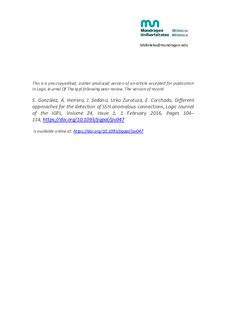Izenburua
Different approaches for the detection of SSH anomalous connectionsEgilea
Argitalpen data
2016Beste erakundeak
Instituto Tecnológico de Castilla y LeónUniversidad de Burgos
Universidad de Salamanca
Bertsioa
PostprintaDokumentu-mota
ArtikuluaArtikuluaHizkuntza
IngelesaEskubideak
© Oxford Academic 2016Sarbidea
Sarbide irekiaArgitaratzailearen bertsioa
https://doi.org/10.1093/jigpal/jzv047Non argitaratua
Logic Journal of the IGPL Vol. 24. Nº 1. Pp. 104–114. February, 2016Argitaratzailea
Oxford AcademicGako-hitzak
Secure Shell Protocol
SSH
Honeynet
Intrusion Detection ... [+]
SSH
Honeynet
Intrusion Detection ... [+]
Secure Shell Protocol
SSH
Honeynet
Intrusion Detection
Classifier
Ensemble
Cross-Validation [-]
SSH
Honeynet
Intrusion Detection
Classifier
Ensemble
Cross-Validation [-]
Laburpena
The Secure Shell Protocol (SSH) is a well-known standard protocol, mainly used for remotely accessing shell accounts on Unix-like operating systems to perform administrative tasks. As a result, the SS ... [+]
The Secure Shell Protocol (SSH) is a well-known standard protocol, mainly used for remotely accessing shell accounts on Unix-like operating systems to perform administrative tasks. As a result, the SSH service has been an appealing target for attackers, aiming to guess root passwords performing dictionary attacks or to directly exploit the service itself. To identify such situations, this article addresses the detection of SSH anomalous connections from an intrusion detection perspective. The main idea is to compare several strategies and approaches for a better detection of SSH-based attacks. To test the classification performance of different classifiers and combinations of them, SSH data coming from a real-world honeynet are gathered and analysed. For comparison purposes and to draw conclusions about data collection, both packet-based and flow data are analysed. A wide range of classifiers and ensembles are applied to these data, as well as different validation schemes for better analysis of the obtained results. The high-rate classification results lead to positive conclusions about the identification of malicious SSH connections. [-]





















